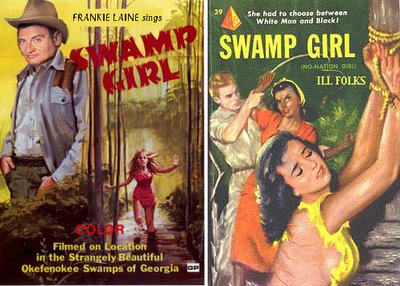
The motto at Frankie Laine's website: "It Ain't Over 'Til It's Over."
And it isn't, even though Frankie died on February 6th, at the age of 93. His unique stylings will continue to amaze and amuse. Time may dim his luster a bit, just as Al Jolson and "Swanee" play to a smaller crowd, but for those of us with a taste for bombast, heroics and yes, a bit of corn, we'll still be playing "Call of the Wild Goose," "Mule Train," and "Jezebel," and feel at least agnostic rather than atheist in hearing "I Believe."
Francesco LoVecchio was born on March 30, 1913, and in his lifetime 21 of his records went gold and he sold over 250 million discs. If he had remained Frank LoVecchio, none of it might have happened, or at best he would be remembered as another Italian pop singer.
But as Frankie Laine, he emerged via Mercury Records as a soulful balladeer, and some figured from his style and his name that he might be black. He sang "Shine," after all, along with "Georgia On My Mind" and "God Bless the Child." He also sang numbers that now seem like soundtracks to noir movies, notably "Satan Wears a Satin Gown."
He really defined himself by three immensely insane singles at Mercury: "Cry of the Wild Goose," "Mule Train" and "Swamp Girl," each of them as lurid and evocative as the cover of a bad paperback novel. These songs gave "Frankie Laine" an identity. He was America, the guts of the country from the bayous of Louisiana up through the parched dirt of Texas. While he would have a hit here and there with "That's My Desire" or "I Believe," and issued many romantic albums for Columbia, he was better known for belting out "Rawhide" and the story-songs for "High Noon" and "Gunfight at the OK Corral."
As ludicrous as it might be, he melded his operatic and Italian tendencies to these gritty ballads, and like Roy Orbison, was somehow able to make a theatrical run up and down the scales into something both pretty and masculine. No ordinary country singer could've or would've flourished the ending of "Gunfight at the OK Corral" the way Frankie did. He got away with it like a bandit. Even the album covers where this guy was dressing up in cowboy outfits and brandishing a gun seemed authentic rather than ridiculous.
To cap off his career, he gave an exciting, serious rendition of "Blazing Saddles," knowing full well that the lyrics made no sense and Mel Brooks was filming a comedy.
I wrote to Mr. Laine some time ago, expressing my admiration for his work, and I'm glad I did. I'm glad he responded, too. The man was still active at 90, and he had loyal fans and a loving family and a long life. It takes a very special performer to make a hit out of some of the tracks that Laine became famous for.
If you want to see him put his heart and soul into a song, watch him deliver "Lord, You Gave Me a Mountain" on David Steinberg's "Music Scene" TV show (on DVD). If you've admired Frankie Laine you probably have a lot of his CDs, and thank you for buying them. It let him know in his 70's and 80's and even 90's, that he was not forgotten, and that the bottom line was the royalty check that proved it.
He never got the respect he deserved. He covered a lot of territory, from jazz to pop to C&W and inspirational songs, and he was as effective with intimate songs as with the bombastic ones. Tony Bennett's practically The Pope these days; I wish sometime in the past decade, somebody brought Frankie Laine center stage for a worthy tribute.
I've chosen "Swamp Girl" for you, because she straddles the fragrant bog between Laine's romantic and jazz side, and his often blinding flare for the dramatic.
He was a great American artist.
SWAMP GIRL
1 comment:
My parents met him after a concert in the 70's, and he was very gracious...I'm proud to say we are
both from Chicago....he was one of the great ones, no doubt....and good point about the orbison-like range....mixed with the dash and
flair of bobby darin and sinatra..
Post a Comment